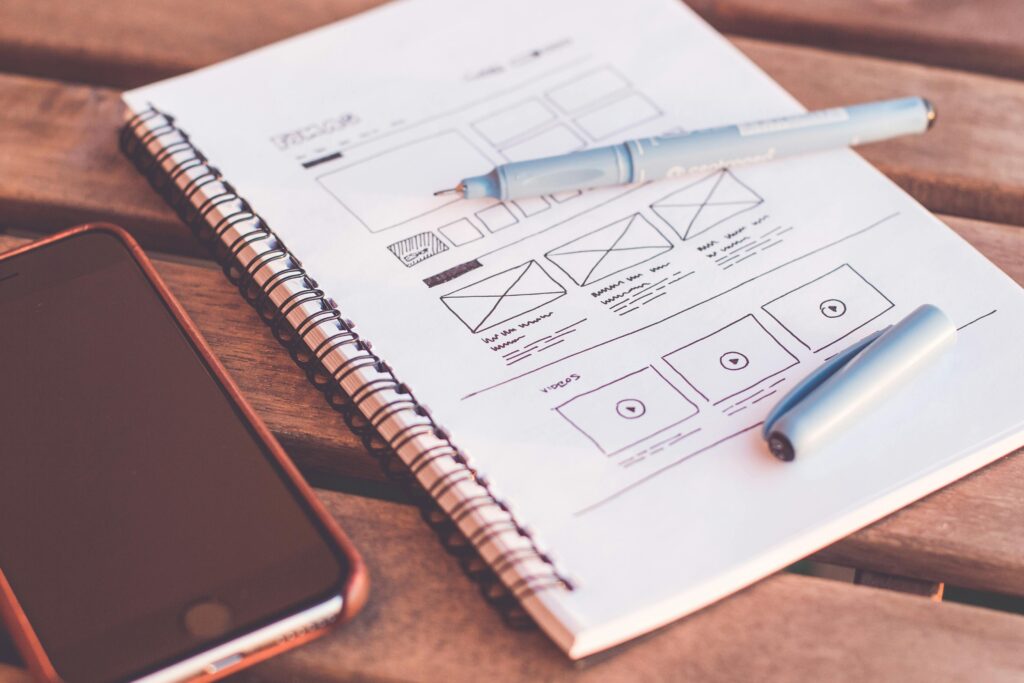
There are several AI-powered UX design tools that can enhance the design process for designers. Here are some essential ones:
Sketch:
Sketch is a popular design tool that offers plug ins powered by AI to assist designers in various tasks such as prototyping, generating assets, and creating animations. Sketch is a versatile design tool that is widely used by designers for creating user interfaces, prototyping, and collaborating with team members. It offers a range of features that make it a preferred choice for many designers, including:
- Vector Editing: Sketch provides powerful vector editing capabilities, allowing designers to create scalable and high-quality graphics easily.
- Symbol Libraries: Designers can create reusable components and design systems using Sketch’s symbol libraries, which help maintain consistency across projects.
- Plugins and Integrations: Sketch supports a wide range of plugins and integrations that enhance its functionality, such as AI-powered plugins for generating assets, prototyping, and streamlining workflows.
- Prototyping Tools: With Sketch’s prototyping tools, designers can create interactive prototypes to visualize user interactions and test usability before finalizing the design.
- Collaboration Features: Sketch enables real-time collaboration and feedback sharing among team members, making it easier to work together on design projects.
Overall, Sketch is a powerful and versatile tool that empowers designers to create stunning user interfaces and streamline the design process with its innovative features and functionalities.
Adobe XD:
Adobe XD uses artificial intelligence to help designers create interactive prototypes and conduct user testing to improve the user experience. Adobe XD is a popular design tool for creating user interfaces, interactive prototypes, and user experiences. Here are some key features and benefits of Adobe XD:
- Design and Prototyping: Adobe XD allows designers to create and iterate on designs quickly and efficiently, with robust design tools for creating layouts, assets, and interactive prototypes.
- Repeat Grid: The Repeat Grid feature in Adobe XD enables designers to create repeated elements such as lists, grids, and card layouts easily, saving time and effort in designing and updating multiple instances.
- Auto-Animate: Adobe XD’s Auto-Animate feature facilitates creating interactive transitions and animations within prototypes, enhancing the user experience and demonstrating the flow of user interactions effectively.
- Collaboration and Feedback: Adobe XD offers collaboration features that enable designers to share designs with team members, stakeholders, and clients for feedback and review, promoting seamless collaboration and communication throughout the design process.
- Plugins and Integrations: Adobe XD supports plugins and integrations that extend its functionality, including AI-powered plugins that assist designers in tasks like content generation, design recommendations, and usability testing.
- Responsive Design: Adobe XD provides features for designing responsive layouts that adapt to different screen sizes and devices, helping designers create designs that are optimized for various platforms and devices.
Overall, Adobe XD is a powerful tool that empowers designers to streamline the design process, create interactive prototypes, and deliver exceptional user experiences with its comprehensive set of features and functionalities.
Figma:
Figma is a collaborative design tool that integrates AI-powered plugins to automate tasks like design consistency checking, user flow mapping, and generating design assets. Figma is a collaborative web-based design tool that is widely used by designers for creating user interfaces, interactive prototypes, and design systems. Here are some key features and benefits of Figma:
- Collaborative Design: Figma allows multiple team members to work on the same design file simultaneously, enabling real-time collaboration, feedback sharing, and version control, promoting efficient teamwork and communication.
- Vector Editing: Figma provides robust vector editing tools that allow designers to create scalable and high-quality graphics, illustrations, and UI elements with precision and flexibility.
- Prototyping and Animation: Figma offers prototyping capabilities that enable designers to create interactive prototypes with transitions and animations, helping visualize user flow and interactions within the design.
- Design Systems: With Figma, designers can create design systems and component libraries to maintain consistency across projects, speed up the design process, and ensure a cohesive user experience.
- Plugins and Integrations: Figma supports plugins and integrations that extend its functionality, allowing designers to access additional tools, resources, and features to enhance their design workflow.
- Responsive Design: Figma provides features for designing responsive layouts that adapt to different screen sizes and devices, helping designers create designs that are optimized for various platforms and screen resolutions.
Overall, Figma is a versatile design tool that empowers designers to collaborate effectively, create interactive prototypes, and streamline the design process with its comprehensive set of features and functionalities, making it a popular choice for design teams and individuals alike.
Uizard:
Uizard is a tool that uses AI to convert hand-drawn sketches into digital wireframes, saving designers time and effort in the initial design phase. Uizard is an innovative design tool that leverages artificial intelligence to assist designers in creating digital prototypes quickly and efficiently. Here are some key features and benefits of Uizard:
- AI-Powered Design: Uizard uses AI algorithms to transform hand-drawn sketches or wireframes into digital designs, saving designers time and effort in the initial design phase.
- Automated Design Generation: With Uizard, designers can automatically generate design assets, such as buttons, images, and icons, based on their input, increasing productivity and streamlining the design process.
- Collaboration and Feedback: Uizard facilitates collaboration among team members by allowing designers to share designs and gather feedback in real-time, promoting better communication and enhancing the design iteration process.
- Design Consistency: Uizard helps maintain design consistency by offering design templates, style guides, and design systems that ensure a cohesive look and feel across different screens and components.
- Prototyping Capabilities: Uizard enables designers to create interactive prototypes with ease, allowing them to visualize user interactions, test usability, and refine the user experience before finalizing the design.
- Time-Saving Solution: By automating repetitive design tasks and offering AI-powered design assistance, Uizard helps designers save time and focus more on creativity and problem-solving in their design projects.
Overall, Uizard is a valuable tool that combines the power of artificial intelligence with design expertise to streamline the design workflow, enhance collaboration, and empower designers to create high-quality digital prototypes efficiently.
Voiceflow:
Voiceflow is an AI-powered tool specifically designed for designing voice user interfaces (VUIs), helping designers create intuitive voice-based interactions for various devices. Voiceflow is a platform that allows users to design, prototype, and launch voice applications and conversational interfaces without needing to write any code. Here are some key features and benefits of Voiceflow:
- Voice Design Interface: Voiceflow provides a visual design interface that allows users to create conversational flows, design voice interactions, and build voice applications using a drag-and-drop editor, making it easy for both designers and non-technical users to create voice experiences.
- Multi-Channel Support: Voiceflow supports multiple voice platforms, including Amazon Alexa, Google Assistant, and more, enabling users to design voice applications for various devices and platforms with ease.
- Collaboration and Sharing: Voiceflow offers collaboration features that allow team members to work together on voice projects, share designs, gather feedback, and review prototypes, promoting seamless teamwork and communication.
- Prototyping and Testing: With Voiceflow, users can prototype voice interactions and test their voice applications in a simulated environment, enabling them to iterate on designs, refine user interactions, and ensure a smooth user experience before launching the voice application.
- Analytics and Monitoring: Voiceflow provides analytics and monitoring tools that allow users to track user interactions, analyze usage patterns, and gather insights on how users are interacting with the voice application, helping optimize and improve the overall user experience.
Overall, Voiceflow is a powerful platform that simplifies the process of designing and building voice applications, empowering designers, developers, and businesses to create engaging and interactive voice experiences without the need for coding skills.
Morpholio Trace:
Morpholio Trace uses AI to provide real-time feedback on design layouts, offering suggestions and insights to help designers refine their designs efficiently. Morpholio Trace is a digital sketching and design platform that is popular among architects, designers, and creatives. Here are some key features and benefits of Morpholio Trace:
- Digital Sketching and Markup: Morpholio Trace allows users to create digital sketches, annotate drawings, and markup designs using a variety of drawing tools, pens, and brushes, offering a natural and intuitive sketching experience.
- Layered Collaboration: The platform enables collaborative work by offering layered drawing capabilities, allowing multiple users to work on different design elements within the same project, facilitating teamwork and design iteration.
- Scale Drawing and Templates: Morpholio Trace provides tools for precision drawing, including the ability to work to scale, use grids, and templates, helping designers create accurate and professional drawings for architectural and design projects.
- Iterative Design Process: Users can easily iterate on designs, make revisions, and explore different concepts within the platform, promoting creativity and exploration in the design process.
- Presentation and Sharing: Morpholio Trace allows users to create polished presentations by assembling sketches, drawings, and annotations into visual narratives, and easily share these presentations with clients, collaborators, or stakeholders.
- Integration with CAD and BIM: The platform offers integration with CAD and BIM software, allowing users to import and overlay architectural plans, 3D models, and other design documentation, enhancing the workflow for architecture and design professionals.
Overall, Morpholio Trace is a versatile tool that caters to the needs of architects, designers, and creatives by providing a digital sketching and collaboration platform that supports the iterative design process and facilitates professional presentations and communication.
These tools can help designers streamline their workflow, improve collaboration, and create user-centered designs with the help of artificial intelligence.




